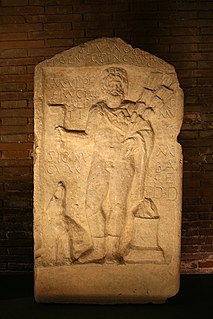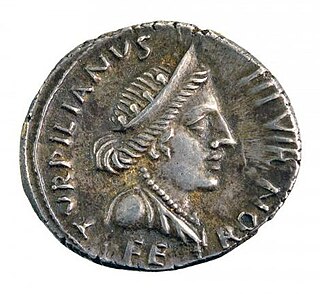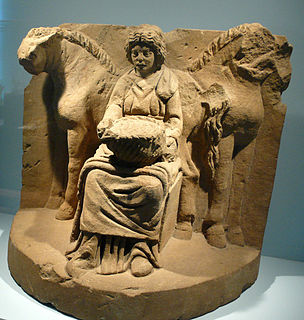Related Research Articles

In Gallo-Roman religion, Cernunnos was a deity depicted with antlers, seated cross-legged, and is associated with stags, horned serpents, dogs, bulls, and rats. He is usually holding or wearing a torc and has been seen holding a bag of coins and a cornucopia. Believed to have originally been a Celtic deity, over 50 examples have been found from this time believed to be associated with him, concentrating in the north-eastern region of what was called Gaul by the ancient Romans. Cernunnos is also associated with the Wiccan Horned God in the modern religious tradition of Wicca.

Mercury is a major god in Roman religion and mythology, being one of the 12 Dii Consentes within the ancient Roman pantheon. He is the god of financial gain, commerce, eloquence, messages, communication, travelers, boundaries, luck, trickery, and thieves; he also serves as the guide of souls to the underworld.

In ancient Roman religion and myth, Faunus[ˈfau̯nʊs] was the horned god of the forest, plains and fields; when he made cattle fertile he was called Inuus. He came to be equated in literature with the Greek god Pan.

In Greek mythology, Cyparissus or Kyparissos was a boy beloved by Apollo or in some versions by other deities. In the best-known version of the story, the favorite companion of Cyparissus was a tamed stag, which he accidentally killed with his hunting javelin as it lay sleeping in the woods. The boy's grief was such that it transformed him into a cypress tree, a classical symbol of mourning. The myth is thus aetiological in explaining the relation of the tree to its cultural significance. The subject is mainly known from Hellenized Latin literature and frescoes from Pompeii. No Greek hero cult devoted to Cyparissus has been identified.

Silvanus was a Roman tutelary deity of woods and uncultivated lands. As protector of the forest, he especially presided over plantations and delighted in trees growing wild. He is also described as a god watching over the fields and husbandmen, protecting in particular the boundaries of fields. The similarly named Etruscan deity Selvans may be a borrowing of Silvanus, or not even related in origin.

In ancient Roman religion, Inuus was a god, or aspect of a god, who embodied sexual intercourse. The evidence for him as a distinct entity is scant. Maurus Servius Honoratus wrote that Inuus is an epithet of Faunus, named from his habit of intercourse with animals, based on the etymology of ineundum, "a going in, penetration," from inire, "to enter" in the sexual sense. Other names for the god were Fatuus and Fatuclus.
In Romano-British religion, Cocidius was a deity worshipped in northern Britain. The Romans equated him with Mars, god of war and hunting, and also with Silvanus, god of forests, groves and wild fields. Like Belatucadros, he was probably worshipped by lower-ranked Roman soldiers as well as by the Britons for whom he was probably a tribal god - a genius loci.

*Nodens or *Nodons is a Celtic healing god worshipped in Ancient Britain. Although no physical depiction of him has survived, votive plaques found in a shrine at Lydney Park (Gloucester) indicate his connection with dogs, a beast associated with healing symbolism in antiquity. The deity is known in only one other location, in Cockersand Moss (Lancashire). He was equated on most inscriptions with the Roman god Mars and likened to Silvanus. His name is cognate with that of later Celtic mythological figures, such as the Irish Nuada and the Welsh Nudd.

In ancient Roman religion, Feronia was a goddess associated with wildlife, fertility, health, and abundance. As the goddess who granted freedom to slaves or civil rights to the most humble part of society, she was especially honored among plebeians and freedmen. Her festival, the Feroniae, was November 13 during the Ludi Plebeii, in conjunction with Fortuna Primigenia; both were goddesses of Praeneste.

In Gallo-Roman religion, Sucellus or Sucellos was a deity depicted as carrying a large mallet and also an olla and/or barrel. Originally a Celtic deity, his cult flourished not only among Gallo-Romans, but also to some extent among the neighbouring peoples of Raetia and Britain. He has been associated with agriculture and wine, particularly in the territory of the Aedui.
Celticisation, or Celticization, was historically the process of conquering and assimilating by the ancient Celts. Today, as the Celtic inhabited-areas significantly differ, the term still refers to making something Celtic, usually focusing around the Celtic nations and their languages.
Illyrian religion refers to the religious beliefs and practices of the Illyrian peoples, a group of tribes who spoke the Illyrian languages and inhabited part of the western Balkan Peninsula since at least the 8th century BC and until the 7th century AD. The available written sources are very tenuous. They consist largely of personal and place names, and a few glosses from Classical sources.

In ancient Roman religion and myth, Mars was the god of war and also an agricultural guardian, a combination characteristic of early Rome. He was the son of Jupiter and Juno, and he was the most prominent of the military gods in the religion of the Roman army. Most of his festivals were held in March, the month named for him, and in October, which began the season for military campaigning and ended the season for farming.

The gods and goddesses of the pre-Christian Celtic peoples are known from a variety of sources, including ancient places of worship, statues, engravings, cult objects and place or personal names. The ancient Celts appear to have had a pantheon of deities comparable to others in Indo-European religion, each linked to aspects of life and the natural world. By a process of syncretism, after the Roman conquest of Celtic areas, these became associated with their Roman equivalents, and their worship continued until Christianization. Pre-Roman Celtic art produced few images of deities, and these are hard to identify, lacking inscriptions, but in the post-conquest period many more images were made, some with inscriptions naming the deity. Most of the specific information we have therefore comes from Latin writers and the archaeology of the post-conquest period. More tentatively, links can be made between ancient Celtic deities and figures in early medieval Irish and Welsh literature, although all these works were produced well after Christianization.

In ancient Roman culture, the olla is a squat, rounded pot or jar. An olla would be used primarily to cook or store food, hence the word “olla" is still used in some Romance languages for either a cooking pot or a dish in the sense of cuisine. In the typology of ancient Roman pottery, the olla is a vessel distinguished by its rounded “belly,” typically with no or small handles or at times with volutes at the lip, and made within a Roman sphere of influence; the term olla may also be used for Etruscan and Gallic examples, or Greek pottery found in an Italian setting.
The Ciconiae Nixae was a landmark, or more likely two separate landmarks, in the Campus Martius of ancient Rome. In A New Topographical Dictionary of Ancient Rome, Lawrence Richardson regards a single site called Ciconiae Nixae as "hypothetical," noting that the subject "has long exercised topographers." The two words are juxtaposed in the regionary lists and located in Region IX near the Tiber River. The 4th-century calendar of Filocalus notes vaguely that the October Horse happened ad nixas, "at the Nixae," suggesting that the regionaries' Ciconiae ("Storks") ought to be taken as a separate entry. Inscriptional evidence also indicates that the Ciconiae was a separate landmark, and that it had to do with wine shipments brought in on the Tiber.
In the religion of the Roman Empire, the Silvanae are nymphs or goddesses associated with the woodland god Silvanus. They are attested by inscriptions mainly in Pannonia, with a little more than a third of the evidence scattered in the rest of the Western Roman Empire. Elsewhere, and in Latin literature, Silvanus is accompanied by nymphs. Silvanae may be a regional preference in naming, not a form of cultic devotion distinct from the Nymphs of Silvanus. Like similar nature deities, Silvanus himself is found sometimes conceived of as plural (Silvani), and Silvani/Silvanae form a male-female complement characteristic of the Roman conception of deity.

Sianna or Stanna is a Romano-Celtic goddess from Roman Gaul, attested epigraphically from Vesunna, who is closely related to the Roman goddess Diana. The goddess Sianna is attested by an inscription composed of five fragments discovered in the buildings of the Vieilles Casernes or ‘old barracks’ in Périgueux (Dordogne), in the ancient territory of the Petrocorii, where she is partnered with the god Telo. By comparison of the various fragments, the suggested restoration is certain, except for the end of the first line and the beginning of the second line: Deo Telo et deae Stannae, solo A(uli) Pomp(eii) Antiqui, Per…ius, Silvani fil(ius) Bassus, c(urator) c(ivium) r(omanorum), consaeptum omne circa templum et basilicas duas, cum ceteris ornamentis ac munimentis, dat, which Noémie Beck translates as, ‘To the god Telo and to the goddess Stanna, Per[…]ius Bassus, son of Silvanus, curator of the Roman citizens, offers, at his own expense, this entire wall erected around their temple on the land of Aulus Pompeius Antiquus, and these two basilicas with the other embellishments and accessories’. This inscription is of great interest, for it mentions the existence of a temple dedicated to Telo and Stanna. The dedicator Per[…]rius Bassus was a Roman citizen and held official functions. He was a curator, which means he had been appointed by the emperor to manage and supervise the finances of the city. He offered a wall, two basilicas, ornaments and accessories extending and embellishing the sanctuary, which was built on the property of the Roman citizen Aulus Pompeius Antiquus. Sianna and Vesunna are two goddesses from the town of Périgueux in the territory of the Petrocorii.
References
- 1 2 3 4 Dorcey 1992 , p. 55.

